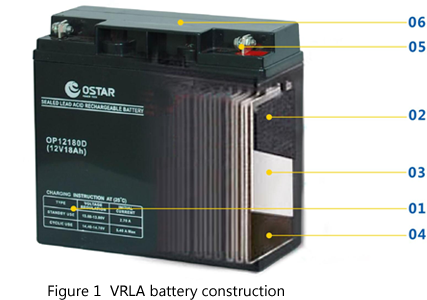1. VRLA Battery Electrochemical Theory and Advantage
1.1.OSTAR POWER VRLA Battery is a backup battery used for portable equipment and office and factory automation. The battery also working in conjunction with solar cells to make a decentralized power supply system.
1.2.Where “charge” is the operation of supplying the VRLA battery (Valve Regulated Lead Acid Battery) with direct current from an external power source to change the active material in the negative plates chemically,and hence to store the battery electric energy in the form of chemical energy,”Discharge” is the operation of releasing the electric energy from the VRLA battery to operate the external equipment and device.
1.3.OSTAR POWER VRLA Battery is small and lightweight that gives high performance making it very economical to use. In addition to these advantages, the sealed construction eliminates the necessity to fill the battery with water.
1.Container: Made of UL94HB and UL94V-0 ABS Plastic.
2.Negative Plates: Use the special Pb-Ca alloy grids optimize the recombination efficiency and less gassing.
3.Separtor: High quality AGM separator.
4.Positive Plates: Pb-Ca grids minimize corrosion and prolong life.
5.Terminal Post: Lead material with maximum conductivity enhance the high current rapidly.
6.Safety Valve: Allows the release of excess gas automatically for safety.

2. Sealing Principle
The charge/discharge reaction of the VRLA battery can be expressed by the following reaction:
| Anode | Electrolyte | Cathode | Discharge | Anode | Electrolyte | Cathode | ||||||
| PbO2 | + | 2H2SO4 | + | Pb | + | ® ¬ | + | PbSO4 | + | H2O | + | PbSO4 |
| Lead dioxide | Sulfuric acid | Sponge lead | Charge | Lead sulfate | Water | Lead sulfate |
Overcharging causes electrolysis of the water content of the electrolyte, which generates O2 gas at the positive plate and H2 gas at the negative plate. These gasses are then discharged to the outside. Since a drop in the electrolyte levels results, adding water is occasionally needed.
The VRLA battery is designed so that the negative plate does not have to be fully charged even when the positive plate is fully charged. Furthermore, no H2 gas is generated from the negative plate although O2 gas is being generated from the overcharged positive plate. O2 generated from the positive plate then reacts with the charged sponge lead (Pb) of the negative plate and turns into lead monoxide (PbO). The lead monoxide, in turn, reacts with sulfuric acid (H2SO4) in the electrolyte to turn into lead sulfate (PbSO4), allowing the negative plate to discharge. In other words, O2 from the positive plate is absorbed by the negative plate without being expelled to the outside. Since the negative plate develops discharging with the help of O2, there always exists a portion free from discharging. As a result, the negative plate never generates H2. This completely prevents the loss of water.
The sealing principle of a VRLA battery may be expressed by the following equation
(See Figure 2 for illustration):
| Negative plate (charged) | O2 gas generated from the positive plate | Negative plate | |||
| Pb | + | ½ O2 | ® | (PbO) | |
| Sponge lead | Oxygen gas | Lead oxide | |||
| for Electrolyte | Negative plate | Electrolyt | |||
| H2O | + | PbSO4 ¬ | H2SO4 | + | (PbO) |
| Water | Lead sulfate | Sulfuric acid |
Figure 2: Illustration of Sealing Principles
CAUTION: ALWAYS USE A BATTERY BEST DESIGNED FOR THE APPLICATION.
This guide is focused on Industrial Standby applications and NOT Automotive or Traction use.
Industrial Batteries
Industrial batteries are available from two distinct groups with the following features. Note: VRLA have superseded open-vented in many applications
| OPEN-VENTED | VRLA/SEALED |
| 1. Older technology | 1. Environmentally friendly |
| 2. Require separated battery room | 2. Use directly in office environment |
| 3. Regular routine maintenance | 3. Low maintenance-“maintenance free” |
| 4. Separate safety requirements | 4. Self-contained. Safe |
| 5. Store/use in vertical position | 5. Store/use in any orientation |
| 6. Can require extensive cabling | 6. Can be used internal or adjacent to load |
VRLA type has replaced the open-vented type in many instances
Note: The term sealed lead-acid SLA is an old acronym Considered misleading and is now replaced by Valve Regulated Lead Acid VRLA.
Specific Applications:
(1) Cycle Use:
· Portable VTR/TV, tape recorders, radios, and etc.
· Power tools, lawn mowers and vacuum cleaners
· Cameras and photographic equipment
· Portable personal computers, word processors, portable terminals and etc.
· Portable measuring equipment· Portable telephone sets
· Various power toys and recreational equipment
· Lighting equipment
(2) Standby Use:
· Communications and electric equipment
· Emergency lighting equipment
· Fire alarms and security systems
· Various telemeter equipment
· Office computers, processors and other office automation equipment
· Robots, control equipment and other factory automation equipment
· UPS power supplies
· Emergency power supplies in power generation plants and substations
· Telecommunications
(3) Solar Cell Power Generation:
· Street lighting· Water pumping stations
· Portable handheld power supplies
· Small town power systems
Product Applications:



BATTERY DISPOSAL/RE-CYCLING
Finally, when a battery has reached the end-of-life it must be returned to the point of sale or to a licensed battery dealer for recycling.
